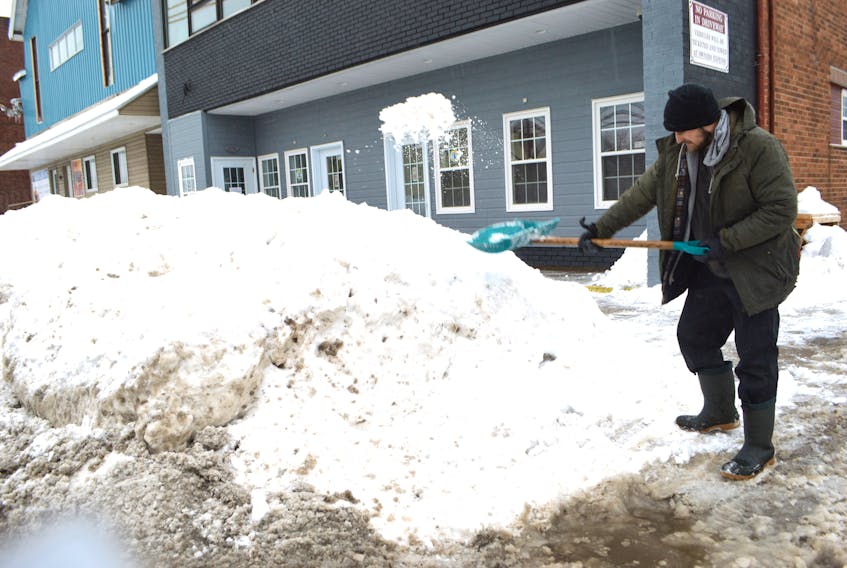SYDNEY, N.S. — There has been no snow month like January — at least for 150 years.
Ian Hubbard, an Environment Canada meteorologist, said 179.8 cm of snow was registered at the Sydney airport in January, which is an all-time record.
“Records go back to 1870,” he said. “It broke the previous record which was 163.03 cm in 1965.”
Five January days registered at least 15 cm of snow and last year only five days registered that amount all winter.
In terms of snow accumulation, records at the Sydney airport from December, January and February, the most snowfall recorded was in 1965 — 426.1 cm. So far this year through December and January there has been 217 cm of snow.
“February would have to be quite an exceptional month to come even close to the 1965 record,” he said.
Hubbard said although it has been a rough winter so far, it’s hard to predict what’s on the horizon.
“There are certainly a number of weeks left of winter for sure.”
In terms of snowy winters, a total of 315 cm of snow dropped in 2014, ranking third overall in the Sydney area. In 2017, a total of 304.7 cm fell, the fifth largest for that three-month span on record.
“We’ve certainly had a number of busy winters in the last decade and for January to have so much snow, it definitely was extraordinary,” he said. “We’ll have to see how February plays out, how that translates to the whole winter season itself.”
Meanwhile, not everyone is tired of the snow.
“Let it snow, let it snow, let it snow,” said Paul Burke, an employee at Ski Ben Eoin, adding he can see the excitement on people’s faces in conjunction with the amount of snow.
“The enthusiasm just carries on through the whole hill, from employees to all the patrons here. It’s a wonderful thing to see.”
SNOW FACTS
Snowfall amounts registered at Sydney airport over past three years:
October-April
- 2018-19, 280.08 cm
- 2017-18, 272.3 cm
- 2016-17, 466 cm
During the month of January, Burke said ski enthusiasts were saying, "bring it on,” adding ski conditions have been awesome.
“We do the snow dance. It’s infectious out here, the enthusiasm that comes from the snow, from the kids, to the adults to the seniors — to everybody.”
Lynden MacDougall, owner of MacDougall’s Snow Removal Service in Sydney, said the significant snowfall has provided a lot of people work, through related services. Although it might be hard on some businesses, the spinoff from employees getting paid to the trucks or loaders needing to be serviced, to equipment needed, it’s good for everybody.
MacDougall has been in business for six years and serves Sydney and surrounding areas. Although he admits it was starting to get a little hard to find places to put the snow, they have the machinery to haul it away.
“We just had to work a little harder and a little longer,” he said. “Longer shifts, but everything is working out good.”
Hubbard explained that Environment Canada forecasts span seven days and provide only an indication of what’s on the horizon. He said forecasters are unable to provide many weather details a week ahead because it is too early to know when a system is actually going to start or end.
For example, he said, it may appear 50 cm of snow is coming, but during the next few days that amount could change several times as weather patterns evolve.
“We don’t like hitting the panic button too early until we start to have confidence that a system is actually going to happen,” Hubbard said.
“Many times these storms might either speed up or slow down which could cause the day they arrive to be a little different or maybe they go further out to sea and may not affect the area like we may have thought.”
According to National Geographic’s website, on April 1, 1960, the United States launched the world's first successful weather satellite into space from Cape Canaveral, Fla. Once satellites were launched into space and able to take pictures of the atmosphere, it was a real game changer for meteorology, Hubbard said.
“Then we were able to actually see what was happening over the entire continent with an image or a picture.”
Prior to that, there were weather observances that would have been sent in to weather offices and with that data, weather maps would have been constructed.
“Which we still do today but we have a lot more help from computers doing that as well.”









